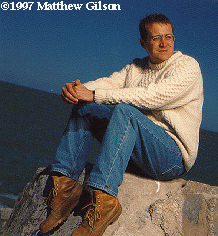
The University of Chicago Magazine
April 1997

Comparing fossil-fuel energy to nuclear energy, geophysicist and oceanographer David Archer looks to the future. "One of the emotional arguments about nuclear energy is, `We're making this waste that is going to be with us for 100,000 years. That's just amoral to be so selfish as to do something that's going to have consequences for that long.'" He then notes that his research shows that 7 to 8 percent of the carbon dioxide released from fossil fuels will remain in the atmosphere twice as long as the nuclear waste. In other words, "the fossil-fuel carbon has that same sort of mind-boggling time scale," says Archer, whose work is supported by a Packard Foundation fellowship for promising young science and engineering professors. "Eight percent doesn't sound like much, but it's a gallon out of a 12-gallon tank of gas." An assistant professor in geophysical sciences, Archer studies the marine carbon cycle, its effect on the amount of carbon dioxide in Earth's atmosphere, and the carbon dioxide's effect on the climate. Higher levels of carbon dioxide increase the greenhouse effect and global warming while lower levels cool things down, but researchers don't know why the levels change. All they know is that the oceans are the earth's only carbon reservoir both large enough and volatile enough to change the atmospheric carbon dioxide concentration on glacial/interglacial time scales. That's of special interest considering that humans have added a twist to nature's enigmatic grand scheme by using fossil fuels as an energy source. When burned, those fuels give off carbon dioxide, and this added source of carbon dioxide may affect the future climate. Archer, for one, speculates that it will take nature a long time to clean up humankind's mess. Carbon comprises 5,000 billion tons, or 5,000 "gigatons," of the planet's remaining available fossil fuels. Following a "business-as-usual" scenario, says Archer, means that about one-third of that carbon will be burned by 2100. When all 5,000 gigatons are consumed, he wondered, how much of the released carbon dioxide will linger-and for how long? The ocean can dispose of much of it relatively quickly; scientists have shown that the oceans' waters will dissolve 70 to 80 percent of the carbon dioxide in just 300 years. What about the rest? Archer chose to concentrate his efforts on sea-floor calcium carbonate, which, when dissolved, chemically neutralizes carbon dioxide. By modeling the ocean's circulation, carbon cycle, and sea-floor sediments, he arrived at his answer: 7 or 8 percent of the carbon dioxide will remain in the earth's atmosphere for the next 200,000 years until it's eliminated through the weathering of igneous rocks. Archer began his work as a Columbia University postdoc, taking a carbonate sediment diagenesis model from his thesis work at the University of Washington and combining it with an ocean model developed by his frequent collaborator, Ernst Maier-Reimer of Germany's Max-Planck-Institut fur Meteorologie. The computer model factors in data on temperature, salinity, and density, using mathematics to predict flow. "It's very coarse resolution, and it's optimized for doing long runs," Archer explains. "Thousands of years, tens of thousands of years." Previous work had found that of the sea floor's massive amounts of calcium carbonate, about 5,000 gigatons could be released--as only sediments in the top ten centimeters of sea floor can interact with the ocean. The 5,000 gigatons would be just enough, Archer originally posited, for the oceans to be able to neutralize all the fossil-fuel carbon one way or another. Unfortunately, he says now, that solution's a little too convenient. Because of clay's high porosity, about 30 percent greater than that of carbonate sediments, those ten centimeters quickly fill with clay as carbonate sediments are chemically eroded from that top layer, giving only about 1,600 gigatons of calcium carbonate a chance to dissolve. "We've lost a factor of three," he says, giving a blackboard lecture-for-one in his Hinds Laboratory office. "But even that's not the end of it."He sketches a chalk graph showing the ocean's levels of calcium carbonate and carbonate ion in equilibrium--where they like to stay. Prior estimates, Archer notes, had assumed all the calcium carbonate would dissolve as added carbon dioxide reacted with the carbonate ion. In actuality, the calcium carbonate will only dissolve enough to reach equilibrium--never neutralizing all the carbon dioxide. These new findings, recently published in Geophysical Research Letters, indicate that calcium carbonate will eliminate another 9 to 15 percent of carbon dioxide over a mere 5,500 to 6,800 years. Calcium carbonate reactions on land dispose of another 3 to 8 percent over 8,200 years. That left him with the 7 to 8 percent figure. Archer admits his model for the future will be more credible when backed by one for the past. Although no one has yet explained the cycle of glacial and interglacial periods, spanning hundreds of thousands of years, many researchers have made guesses. "All of chemical oceanography," says Archer, "is obsessed with trying to figure out why that cycle happened." He hopes to construct, via computer, a model of ocean circulation during glacial times and to synthesize that with data on that period's ocean chemistry.In the meantime, Archer's not too shy to second the notion that fossil-fuel burning and its attendant carbon dioxide increase could cancel the next ice age. "Might be a good thing, you know," he says. In the short run, big climate changes could be harmful to people, but in the long run the planet can probably take care of itself.--Written by Kim Sweet Go to:Precarious Balance
Carbon dioxide released from fossil fuels could linger in the atmosphere for thousands of year, causing dramatic climate changes.
 It's elemental: David Archer studies how water and air maintain their equilibrium.
It's elemental: David Archer studies how water and air maintain their equilibrium.More Investigations:
Also in Investigations:
Return to April 1997 Table of Contents